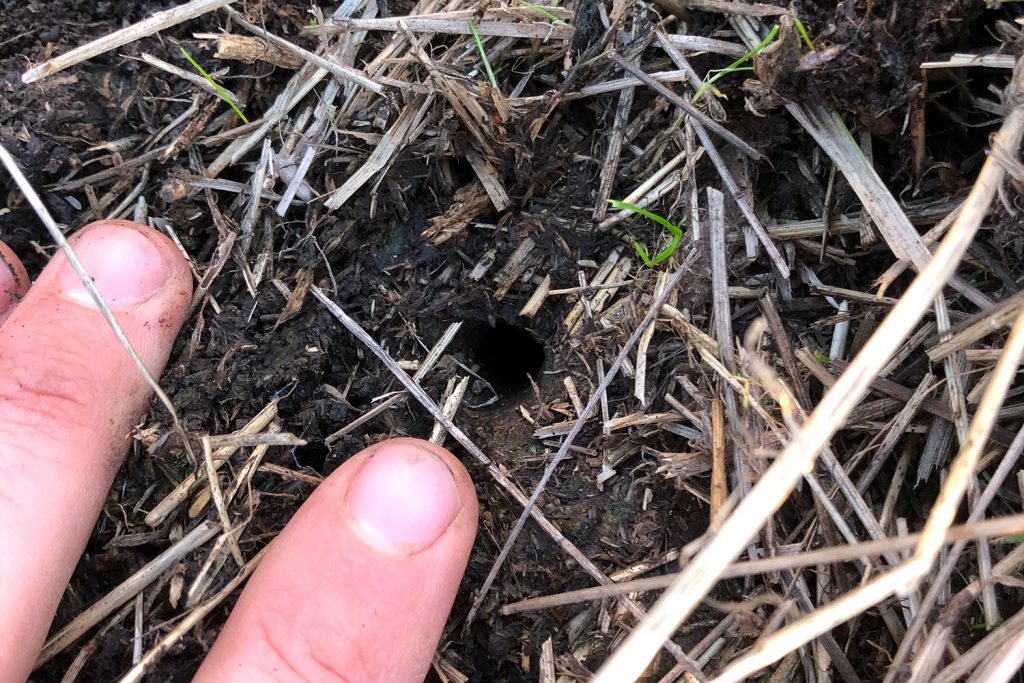Large numbers of underground grass grub (Oncopera fasciculatus) larvae have caused pasture damage on a property near Coleraine in the Glenelg-Hopkins region of Victoria.
They were found in a mixed population with Proteuxoa sanguinipuncta (also known as Peripyra sangunipuncta) larvae, a species that can look and behave similar to armyworm but is chubbier-looking and can be distinguished by a white diagonal stripes near its rear.
A patch of pasture tunnel moth (Philobota sp.) was also observed on the property.
While Proteuxoa sanguinipuncta and pasture tunnel moth larvae are known to feed on pasture, most of the damage has been attributed to the underground grass grub larvae.

Photo by Josh Brown 
Photo by Josh Brown
Who is the underground grass grub?
At the time of writing this article if you google image search the term ‘underground grass grub’, you are likely to see many images of cockchafers and scarab larvae.
While underground grass grub larvae can be a pasture pest like some of these scarab ‘grubs’, these images can be misleading as the underground grass grub is a type of moth, not a beetle.
The term underground grass grub refers to the species Oncopera fasciculatus, a moth that is endemic to Victoria and South Australia belonging to Hepialidae family, also known as ghost or swift moths.
This moth family includes some pretty large species including the rain moth (Trictena atripalpis), which can have a 16 cm wingspan!
Compared to some of its relatives, the moth of the underground grass grub is much smaller, with a wingspan of 35 – 45 mm, however this is still quite large compared to other moths relevant to agriculture.
Underground grass grub is also large at the larval stage, growing up to 50 – 60 mm long. These larvae have a greyish-green body with distinct raised, darker patches around their body hairs (setae).
What is the biology of the underground grass grub?
The underground grass grub has a one-year life cycle and one generation per year.
Adults emerge from pupae and lay eggs during early spring that hatch after 3 – 5 weeks.
The larvae create vertical silk lined tunnels in the soil where they live for most of their immature life stage. They emerge above ground at night to feed on pastures, including grass and clover species, often dragging foliage back into their tunnel, although they can occasionally be seen on the soil surface during the day.
When larvae are fully grown, they eventually enter a ‘pre-pupal’ stage, and their body contracts and becomes a creamy-yellow colour, with pupation occurring two weeks after. This pre-pupal form can be found in the soil from July.

The underground grass grub belongs to the same genus (Oncopera) as the corbie (Oncopera intricata) and winter corbie (Oncopera rufobrunnea), which also create vertical tunnels in the soil.
While the underground grass grub is endemic to Victoria and South Australia and doesn’t cross over in distribution with the corbie (the latter is restricted to Tasmania), in Victoria it may be confused with the winter corbie, which is found across Victoria, New South Wales and Tasmania.
It can be difficult to distinguish different Oncopera larvae by eye and identification between species comes down to differences in body hair arrangement; identification in the field is much easier at the adult moth stage during the warmer months.
Note that there are also several other invertebrate species which create tunnels in the soil, some of which are pasture pests.
For example, recently pasture tunnel moth (Philobota sp.) larvae and their tunnels were found in the same paddock as underground grass grub larvae. However, pasture tunnel moth larvae tunnels are ‘chimney like’ and protrude above ground level, whereas Oncopera tunnels open at ground level.
If you are seeing soil tunnels and pasture (or crop) damage, contacts us for assistance with discovering who lies beneath.

Photo by Josh Brown 
Photo by Josh Brown
Acknowledgements
Thanks to Josh Brown (McDonald Rural Services) for providing field observations and samples.
This article draws on information from the following studies:
Madge P, A field study on the biology of the underground grass caterpillar, Oncopera Fasciculata (Walker) (Lepidoptera: Hepialidae), in South Australia., Aust J Zool 2:193–204 (1954).
Martyn E, The ecology of Oncopera intricata Walker and Oncopera rufobrunnea Tindale (Lepidoptera, Hepialidae) with notes on the classification of the genus Oncopera in relation to larval taxonomy, Res Bull Dep Agric Tasmania 3 (1960).
Cover image: Photo by Josh Brown





